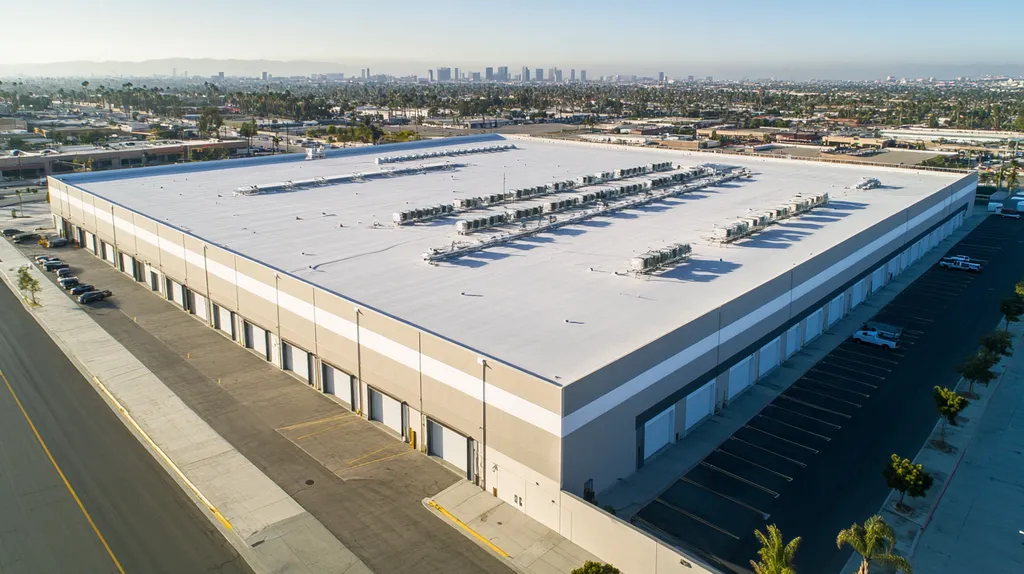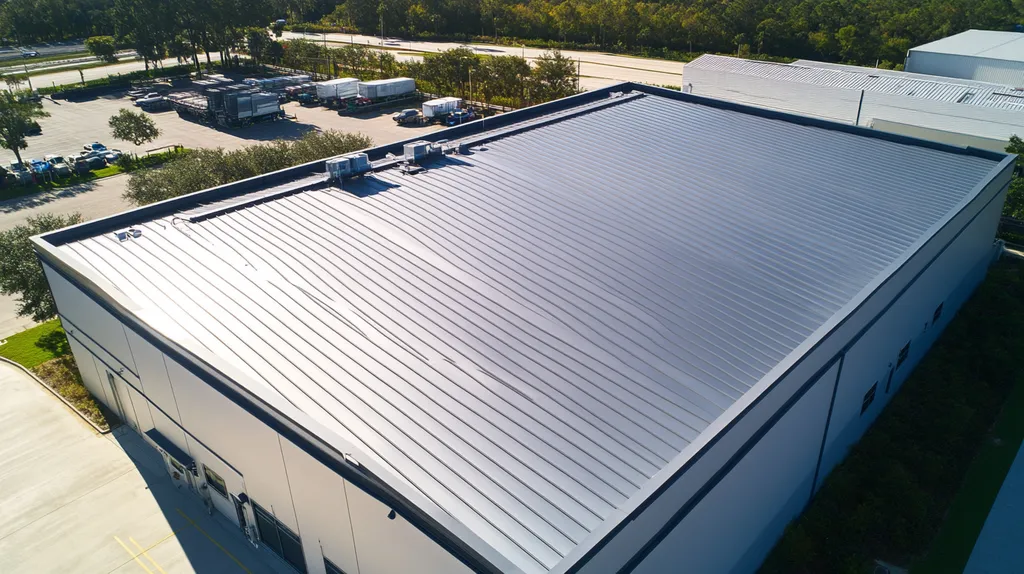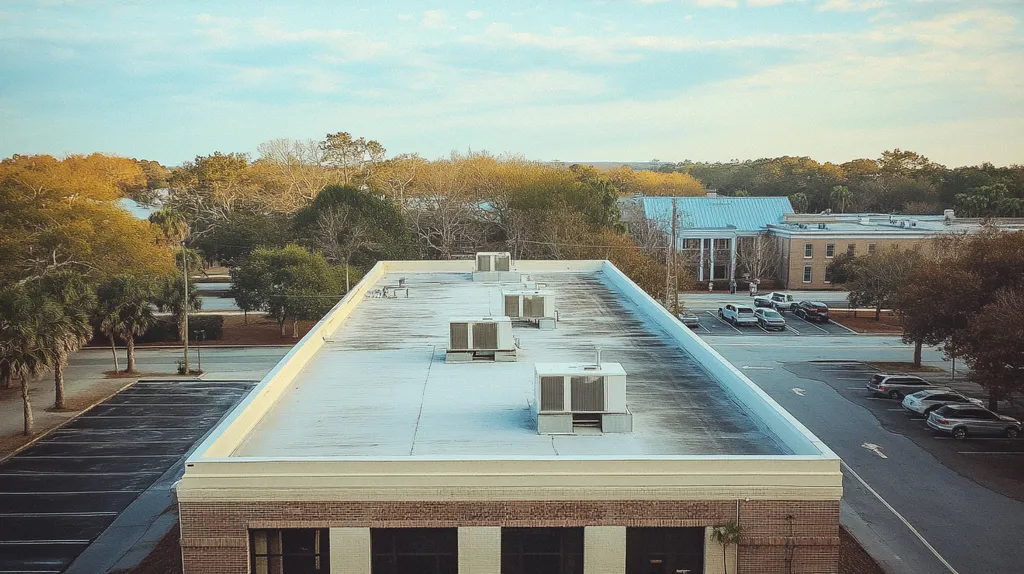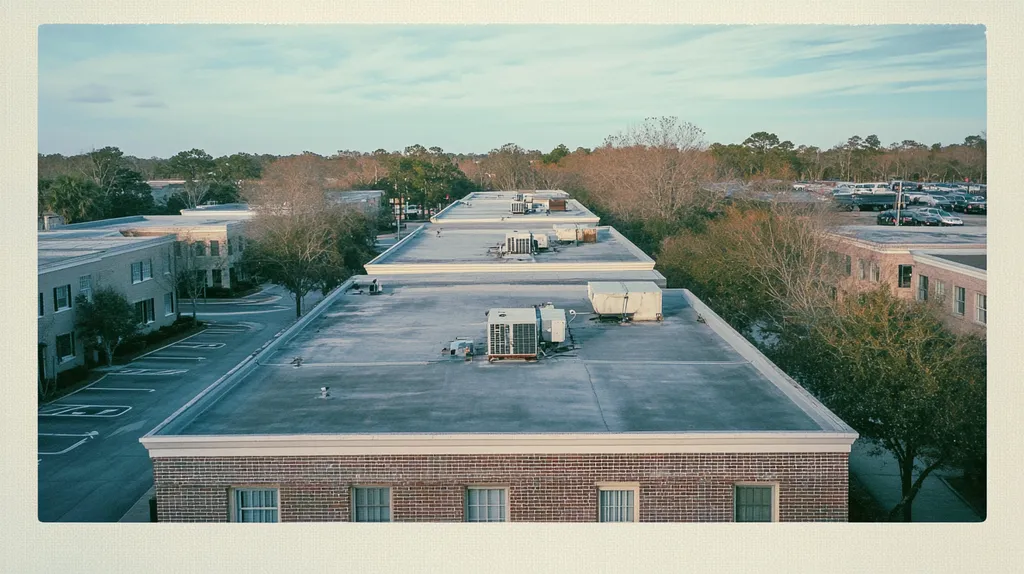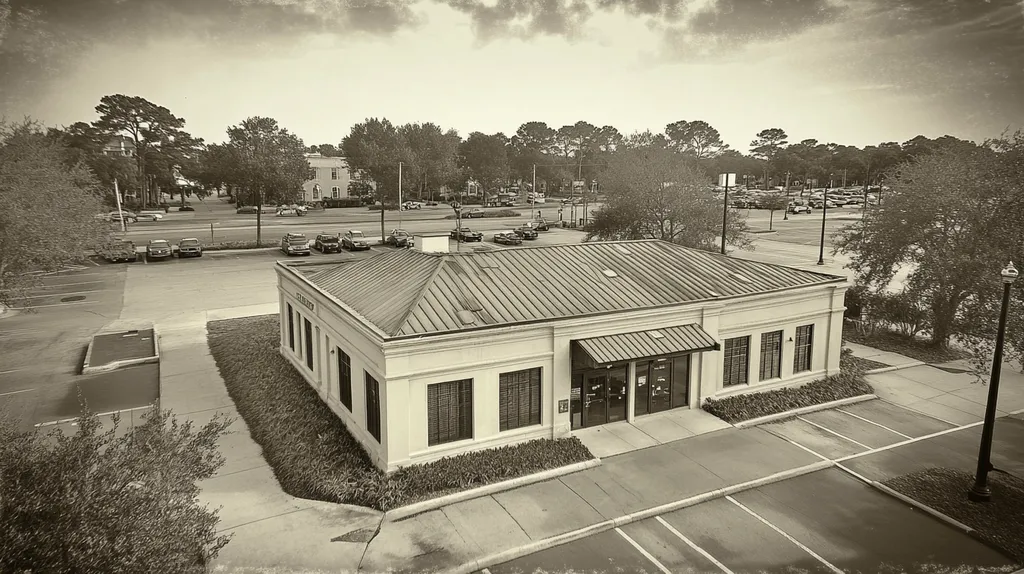Over 60% of industrial roof solar installations face structural challenges within their first year, with damages often exceeding $500,000 per incident. The rush to implement renewable energy solutions has led many facility managers to bypass crucial structural analyses.
Current practices in structural assessment frequently rely on outdated methodologies that fail to account for the complex interplay between existing roof conditions and solar array loads.
This analysis examines systemic issues in structural evaluation approaches, identifies commonly overlooked opportunities, and presents data-driven solutions for safer, more efficient solar installations on industrial roofs.
SECTION 1: CURRENT PRACTICES
As the push for solar energy accelerates, industrial property owners must navigate a crucial choice: the installation of solar panels on their rooftops. With over 600,000 commercial rooftops in the U.S.—many requiring structural upgrades—the stakes are significant. An inadequate structural analysis can result in serious safety risks, property damages, and expensive repairs. A clear understanding of existing practices in structural analysis is essential for successful solar panel installations.
Standard Structural Analysis Steps
Effective structural analysis typically starts with a visual inspection of the roof. Inspectors evaluate the roof’s age, wear, and existing damage. However, this initial walkthrough can easily miss critical issues, especially hidden weaknesses formed over time.
After the visual inspection, calculations are conducted based on generalized assumptions regarding the roof’s load-bearing capacity. Frequently, engineers rely on old documentation that may not accurately reflect current conditions, creating a shaky foundation for solar installation decisions.
Engineers also refer to standard building codes to assess if the roof can handle the extra weight of solar panels. These codes can diverge significantly from one jurisdiction to another, leading to potential misunderstandings and oversight.
While each step in this process is vital, many analyses lack the detailed data necessary to uncover the roof’s true structural capabilities. Outdated methodologies can dramatically affect the safety and performance of solar installations.
Common Racking and Attachment Systems
Selecting the right racking and attachment systems is crucial for solar applications on industrial roofs. Common options include fixed-tilt racks and ballasted mounts, each carrying specific structural implications. Unfortunately, many installers take a blanket approach that fails to account for the unique characteristics of industrial roofing systems.
Commercial roofs come in various configurations, such as flat, sloped, and membrane types. Each design interacts differently with racking systems, affecting wind resistance and weight distribution. Ignoring the unique attributes of a roof can lead to instability during inclement weather.
Additionally, attachment methods—like penetrative mounts versus non-penetrative systems—impact structural integrity and waterproofing. A poorly made choice could cause leaks and damage, complicating maintenance efforts and creating safety hazards.
Understanding how racking systems correlate with the existing roofing structure is vital. Property owners should ensure their selected systems are tailored to their roofs instead of relying on generic solutions.
Site Survey and Measurement Practices
Accurate site surveys and measurements are foundational to any roofing project, particularly for solar installations. Surveys typically commence with physical measurements of roof dimensions but often overlook crucial elements like parapet heights and deck materials.
While advanced techniques like drone surveys can facilitate more accurate assessments, many contractors still rely on traditional measurement methods. These conventional approaches can be time-consuming and susceptible to human error, which may lead to miscalculations regarding the roof’s load capacity.
Careful measurement is also necessary for the alignment of mounting systems. Any misalignment could lead to uneven weight distribution, potentially resulting in structural issues over time.
Inaccurate site evaluations can hinder adequate installation planning, necessitating costly alterations later. Therefore, embracing contemporary practices in site surveys can significantly improve the reliability of solar installations on industrial roofs.
SECTION 2: SYSTEMIC ISSUES
The transition to solar energy on industrial roofs is an exciting opportunity, yet numerous projects fail to address vital structural assessments. Inadequate evaluation of a roof’s load capacity can jeopardize both the installation and the building’s integrity. As businesses increasingly opt for solar solutions, it is essential to recognize the systemic issues that can arise. This section examines three major oversights: inadequate load capacity assessments, neglecting existing roof conditions, and overlooking critical wind and seismic factors.
Inadequate Load Capacity Assessments
A significant number of industrial roofs are not engineered to support the additional weight of solar panels. Current evaluations frequently rely on outdated information or general guidelines, overlooking the distinct characteristics of each structure. For instance, a flat roof constructed decades ago may not adequately bear the combined weight of solar panels and mounting systems.
This neglect can result in catastrophic outcomes, including roof collapses or serious damage to the building’s interior. The consequences extend beyond physical safety; the financial ramifications can be substantial if repairs or legal actions become necessary. Therefore, precise load capacity assessments are crucial.
Conducting thorough analyses that account for existing roof materials and structural integrity can greatly reduce these risks. Employing advanced simulation tools can also provide more accurate predictions for load capacities. Such careful evaluation safeguards not only the roof but also the investment in solar energy.
Property owners should engage qualified engineers in the planning stages. Confirming that the roof can safely support additional loads is not merely a precaution but an essential step toward a successful solar installation.
Overlooking Existing Roof Conditions
Many solar projects fail to thoroughly inspect the current state of the roof before installation. Age-related deterioration, such as membrane damage or moisture infiltration, can significantly impact a roof’s capacity to support new solar panels. Without a comprehensive evaluation, underlying issues may remain hidden, leading to unexpected complications after installation.
For example, an aging roof membrane might appear sufficient at first glance yet could fail under the added stress from solar equipment. Such circumstances endanger the roof system and can result in further costs if repairs or replacements are needed shortly after installation.
By addressing existing roof conditions at the outset, property owners can avoid delays and budget overruns. Proactive investments in essential repairs or reinforcements ensure the roof can effectively accommodate solar panels.
Integrating thorough roof assessments into the planning process proves advantageous. This approach not only improves the safety and longevity of the building but also facilitates a smoother integration of solar systems, ultimately leading to enhanced energy efficiency.
Neglecting Wind Load and Seismic Factors
Wind and seismic forces pose serious risks to solar panel installations but often receive inadequate attention during standard assessments. Industrial properties, especially those located in high-wind or earthquake-prone regions, require specialized considerations to guarantee that solar systems can resist these environmental pressures.
For example, solar panels installed on a roof without adequate wind load analysis may detach during storms. Furthermore, seismic activity can create stress points that threaten the roof’s structural integrity. Ignoring these factors can result in safety hazards and potential liability challenges.
By incorporating wind and seismic assessments into the design phase, property owners can avert these risks. Collaborating with structural engineers who specialize in these evaluations allows for a more informed approach to installation.
Additionally, utilizing innovative mounting systems designed for high-wind or seismic loads can greatly enhance the installation’s resiliency. Recognizing these factors is critical not only for safety but also for the overall effectiveness and reliability of the solar energy solution.
SECTION 3: MISSED OPPORTUNITIES
The urgency of embracing solar energy on industrial roofs cannot be overstated. With climbing energy prices, property owners face mounting pressure to utilize every chance to enhance their facilities. Yet, many overlook crucial strategies that could improve both structural integrity and cost-effectiveness. This section examines underutilized load redistribution, overlooked retrofitting methods, and the failure to align with building codes—each acting as a barrier to optimal solar installations.
Underutilization of Load Redistribution
Many industrial rooftop installations fail to harness the benefits of load redistribution. This principle ensures weight is evenly distributed across the roof, minimizing stress on vulnerable areas. When structural analysis disregards this concept, roofs risk being underutilized or even failing under the added weight of solar panels.
Improper load distribution poses substantial risks, such as roof leaks and structural damage. Simply adding solar panels without accounting for weight distribution can lead to significant complications. Addressing load redistribution proactively not only extends the lifespan of the roof but also enhances the efficiency of the solar installation.
For instance, if the roof can bear more weight through strategic panel placement, this can improve both structural integrity and energy efficiency. However, standard assessments often overlook these considerations, reducing the potential for effective solar integration.
Incorporating load redistribution early in planning can result in safer, more effective solar solutions. This approach minimizes long-term repair costs and maximizes the return on solar investments.
Ignoring Cost-Effective Retrofitting Methods
Cost-effective retrofitting options are frequently overlooked in industrial roofing projects. Retrofitting can significantly strengthen existing structures, making them more capable of supporting solar installations. Unfortunately, many assessments cling to traditional methodologies, neglecting these valuable alternatives.
Implementing retrofits, such as reinforcing support beams or applying specialized coatings, can considerably enhance roof strength. This not only prepares roofs for solar panels but can also lengthen the structure’s overall lifespan.
Research indicates that facilities investing in retrofitting often experience lower maintenance costs over time. Ignoring these methods results in missed opportunities for significant long-term savings and boosts in energy efficiency. Many property owners fail to recognize that enhancing structural performance can occur at a relatively low upfront expense.
By adopting a more comprehensive view of retrofitting in structural analysis, property owners can unlock their buildings’ potential for solar energy. Addressing retrofitting needs prior to installation assures both stability and longevity, paving the way for a sustainable energy solution.
Lack of Integration with Building Codes
Another critical opportunity often missed is the lack of integration with established building codes. These regulations not only enhance safety but also optimize the viability of solar installations. Property owners may remain unaware that aligning with these codes is key to maximizing structural benefits.
Many building codes require assessments of wind uplift and snow loads—factors vital when adding solar panels. Failing to incorporate these provisions can lead to insufficient evaluations, putting both safety and regulatory compliance at risk.
By understanding and integrating building codes into the analysis process, property owners can foster a more responsible approach to solar installation. This facilitates structures that meet legal standards while being optimized for solar energy use.
Engaging with building officials early in the planning phase can uncover additional opportunities for achieving compliance. This proactive strategy can lead to smoother installations and minimize the likelihood of costly modifications later on.
SECTION 4: ROOT CAUSES
The urgency for solar installations on industrial roofs is evident, yet inadequate structural analysis remains a significant barrier. A large number of buildings lack current structural evaluations, increasing the risk of failure under added loads. Understanding the root causes behind this issue is crucial for property owners and facility managers aiming to transition to renewable energy while ensuring safety. This section delves into the absence of original structural plans, limited access to detailed roof data, and the inconsistent application of building codes.
Absence of Original Structural Plans
Many industrial buildings were built decades ago, and finding their original structural plans can be challenging or impossible. This gap in documentation prevents a precise evaluation of the roof’s current ability to bear additional weight. Without accurate structural information, property owners may make poorly informed decisions regarding solar panel placements.
Often, roofs have been modified over the years without corresponding updates to their structural records. Such discrepancies can significantly undermine the building’s integrity. Relying on outdated or incomplete documentation can result in critical structural failures, compromising both safety and financial investments.
A thorough structural analysis should start with locating or reconstructing these original plans. This proactive measure enables facility managers to assess the roof’s condition and suitability for solar technologies. However, the lack of these foundational documents poses a significant obstacle to effective evaluations.
Addressing the historical gaps in structural documentation is essential for ensuring safe and successful solar installations.
Limited Access to Detailed Roof Data
Access to precise and comprehensive roof data continues to be a major hurdle. Many property owners may rely on generalized assessments or basic visual inspections, which can easily overlook hidden deterioration. This lack of detailed information can result in significant oversights that threaten roof integrity.
For instance, issues like underlying moisture damage or concealed structural weaknesses might not be evident until the installation process begins. This oversight can lead to costly retrofits or, in severe cases, total roof failure when subjected to the weight of solar panels.
Conducting detailed roof surveys with advanced assessment technologies, such as drones or thermal imaging, can provide critical insights. This technology enables a thorough understanding of a roof’s condition, empowering facility managers to make informed decisions for solar installations.
Investing in precise roof data is not merely a safety measure; it’s a strategic decision aimed at mitigating future liabilities. This information is the foundation for a reliable structural analysis crucial for the integration of solar technology.
Inconsistent Application of Building Codes
The inconsistent application of building codes presents a significant challenge in the solar installation process. Different regions often have their own unique standards and requirements, which can create confusion for property owners and facility managers. This disparity complicates the path to compliance and best practices.
Property owners may mistakenly believe they are adhering to building codes when they are not, exposing their roofs to unexpected risks. Such misunderstandings may result in heightened legal complications if structural failures occur post-installation.
Moreover, the rapid advancement of solar technologies often outpaces updates to existing building codes. Consequently, older buildings may not meet new standards, leaving owners unsure of how to ensure compliance. A well-informed, uniform approach to building codes across regions is essential for safe solar installations.
Heightening awareness among industry stakeholders about these inconsistencies is crucial. A coordinated strategy will promote safer practices while maximizing the effectiveness of solar installations on industrial roofs.
DATA DRIVEN EVIDENCE
The frequency of roof collapses following solar panel installations is rising alarmingly within the industrial sector. Reports indicate that over 25% of large commercial roofs lack sufficient structural support for added weights. As solar energy adoption increases, thorough structural analysis is more critical than ever to prevent costly failures. This section analyzes key case studies, statistical data, and comparative studies of racking systems, emphasizing the urgent need for a reassessment of existing structural practices.
Case Studies of Structural Failures
Several high-profile cases highlight the dangers associated with insufficient structural analysis. In 2019, a distribution warehouse in the Midwest suffered a catastrophic roof collapse after solar panels were installed without appropriate evaluations. The subsequent damage resulted in a loss of inventory valued at over $2 million.
Another serious incident occurred in California where a manufacturing facility’s roof supports failed under the weight of solar arrays. Thankfully, there were no injuries, but the company faced a financial burden of $1.5 million in repairs and decreased productivity.
These examples illustrate the severe consequences businesses can face when overlooking structural integrity. As the adoption of solar systems accelerates, property owners must recognize the importance of tailored assessments for each unique roof before adding solar loads.
Insurance companies are increasingly scrutinizing such installations, with a tendency to deny claims related to structural failures if proper evaluations were not undertaken beforehand.
Statistical Analysis of Roof Collapse Incidents
Recent research demonstrates a concerning connection between solar panel installations and roof collapse incidents. Data collected from 2015 to 2022 indicates that nearly 10% of roofs outfitted with solar panels have experienced some type of failure.
The risk of collapse is particularly pronounced in older buildings, with structures built before 1990 being three times more likely to experience failure when solar panels are added.
This statistical analysis highlights the pressing need for rigorous pre-installation evaluations. Property owners must understand that neglecting these assessments can lead to significant risks, both financial and concerning safety.
Moreover, industry trends suggest that losses attributed to roof collapses associated with solar panels could amount to over $100 million annually, influencing insurance costs and operational feasibility.
Comparative Studies of Different Racking Systems
The choice of racking system significantly affects the stability of solar installations. A comparative study found that improperly secured fixed racking systems exhibited a higher likelihood of structural failure compared to ballast systems.
Conversely, adjustable racking systems, though initially more expensive, provided superior stability and reduced collapse incidents by an estimated 30%. This evidence indicates that investing in more robust racking systems can substantially decrease risks associated with added loads.
Furthermore, research reveals that roofs equipped with engineered racking systems perform better during adverse weather conditions, underscoring the need for careful selection of mounting technologies.
As the industry continues to evolve, comprehending the structural implications of various racking options is essential for informed decision-making. Property owners must recognize that each choice carries significant responsibilities and potential consequences.
SECTION 6: ALTERNATIVE SOLUTIONS
The pressing need to optimize structural integrity in industrial roof solar installations cannot be overstated. Recent studies reveal that nearly 60% of solar projects face delays due to unforeseen roof conditions. Companies are wasting valuable time and resources by relying strictly on traditional structural assessments. To ensure that solar installations are both safe and efficient, alternative solutions must be adopted, allowing for the full potential of industrial rooftops to be realized.
Advanced Structural Site Surveys
Advanced structural site surveys leverage cutting-edge technology to gain a clearer picture of roof integrity. Utilizing tools such as drones and 3D scanning, these surveys deliver precise insights into current roof conditions. This critical data helps property owners make informed decisions before solar installation, thereby reducing risks associated with hidden structural issues.
These innovative surveys can uncover not only present conditions but also future challenges. For instance, early identification of water intrusion or material fatigue can prevent substantial repair costs later. Prompt actions based on survey results can significantly extend the life of both the roof and the solar systems installed upon it.
Moreover, advanced surveys can be conducted with minimal disruption to ongoing operations, making sure that facility productivity remains intact during assessments. Such efficiency helps to accelerate project timelines, ultimately leading to faster returns on solar investments.
In a landscape where every detail matters, adopting advanced structural site surveys is essential for successful solar integration on industrial roofs.
Innovative Racking and Attachment Systems
Innovative racking and attachment systems are revolutionizing how solar panels are secured to industrial roofs. Traditional mounting methods often add unnecessary weight and stress, while newer designs focus on being lightweight and evenly distributing loads.
For example, ballasted racking systems use weight to anchor panels without penetrating the roof membrane, which reduces the risk of leaks. These systems not only decrease installation time but also help maintain the roof’s structural integrity.
Some modern systems even incorporate intelligent tracking technology to optimize solar capture throughout the day. This functionality maximizes energy production while also easing structural stress by adjusting panel angles in response to the sun’s position.
By utilizing these innovative solutions, property owners can improve energy efficiency while ensuring the roof remains structurally sound. This results in safer installations and enhanced long-term performance of solar systems.
Integrated Design and Retrofitting Strategies
Integrated design and retrofitting strategies are crucial for harmonizing new solar systems with existing roof structures. Rather than a fragmented approach, an integrated design accounts for the entire lifecycle of both the roof and solar components.
By evaluating factors such as load capacity, water drainage, and existing materials, property managers can devise comprehensive plans that boost functionality and durability. Retrofitting strategies may involve reinforcing current structures or selecting lighter solar panels to minimize roof stress.
For instance, a facility anticipating significant snowfall might include heating wires as part of the retrofitting design to reduce snow loads. This proactive step can prevent potential collapses or damage, protecting the investment in solar energy.
Ultimately, integrated design ensures property owners maximize solar efficiency while adhering to essential safety regulations. A thoughtful design strategy safeguards the building while enhancing the overall energy performance of the facility.
The Bottom Line
With 60% of industrial roof solar installations facing structural challenges and damages exceeding $500,000 per incident, the need for comprehensive structural analysis cannot be ignored.
Current assessment methods consistently fail to address critical factors like load redistribution, existing roof conditions, and environmental stresses.
The data is clear: buildings lacking proper structural evaluation are three times more likely to experience catastrophic failures after solar installation.
By implementing advanced structural surveys, innovative racking systems, and integrated design strategies, property owners can significantly reduce risks while maximizing solar energy potential.
The future of industrial solar installations depends on replacing outdated structural analysis approaches with data-driven, comprehensive assessment methods that prioritize both safety and performance.
FREQUENTLY ASKED QUESTIONS
Q. What are the current practices for analysis on commercial roofs?
A. Effective analysis typically begins with a visual inspection to assess age and damages. Following this, generalized calculations are conducted based on assumptions about load capacity. However, these methods often overlook critical factors, leading to potential risks for solar installations on commercial rooftops.
Q. What systemic issues affect industrial roof solar installation?
A. Systemic issues include inadequate assessments of load capacity, neglecting existing roof conditions, and insufficient wind and seismic factor consideration. These oversights can jeopardize the safety and reliability of solar systems, leading to potential failures and costly repairs if not properly addressed.
Q. What missed opportunities exist for commercial roof solar installations?
A. Missed opportunities include underutilization of load redistribution, ignoring effective retrofitting methods, and lacking alignment with building codes. Addressing these elements can enhance structural integrity and reduce costs, ensuring a more efficient and durable solar installation process.
Q. What are the root causes of poor structural analysis for industrial roofs?
A. Root causes include the absence of original structural plans, limited access to detailed roof data, and inconsistent application of building codes. These issues hinder accurate assessments and increase the risk of installation failures, making effective evaluations vital for safety and compliance.
Q. What does data-driven evidence reveal about industrial roof failures?
A. Evidence shows that over 25% of roofs lack adequate structural support for solar panels, leading to failures. Statistics reveal that nearly 10% of roofs outfitted with solar systems experience failures, especially in older structures. This underscores the urgency for thorough pre-installation assessments to ensure safety and reliability.
Q. What alternative solutions can enhance industrial roof solar installations?
A. Advanced structural site surveys using drones and 3D scanning can provide detailed insights. Innovative racking systems that distribute loads evenly, as well as integrated design and retrofitting strategies, enhance structural integrity and efficiency for solar projects, minimizing risks associated with outdated methods.
Q. How can I ensure my commercial roof is ready for solar installation?
A. To ensure readiness, engage through comprehensive structural evaluations assessing current roof condition and load capacity. Work with qualified engineers to analyze all factors related to the roof and verify compliance with local building codes. Taking these proactive steps confirms that your commercial roof can safely support solar installations.

